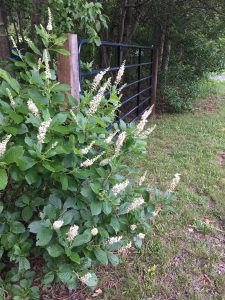 Each year there are countless new varieties of improved ornamentals, but it’s often the old reliables that can best withstand flood and drought and return to grace another season.
Each year there are countless new varieties of improved ornamentals, but it’s often the old reliables that can best withstand flood and drought and return to grace another season.
While recently traveling the coastal back roads of southern New Jersey, you may have enjoyed the final bloom of sweet pea, honeysuckle, Sweet Bay Magnolia and more recently, the orange-red bloom of trumpet vine and dainty filigree of Queen Anne’s Lace. Soon you’ll see the pristine white spires of Summersweet (Clethra alnifolia) at the edge of woodland and abandoned field as it blooms against deep-green, toothed leaves. Even if you don’t see it, you’ll catch its heady summer fragrance on the breeze.
On your travels, you might also find delicately flowered, yet truly hardy, trees and shrubs blooming beside weathered houses and in forgotten corners of old cemeteries.
One of the loveliest of these antique beauties is just reaching full-flower. Vitex agnus-castus prefers damp areas, from sea-level to 2,000 feet and thrives in coastal gardens (offer protection from harsh winds). A multi-stemmed deciduous shrub, Vitex reaches 15 feet tall and prunes nicely into an ornamental tree. The bluish gray-green leaves are palmate clusters (like the fingers on a hand) of 3-7, and the fragrant flowers bloom on lavender-blue spikes up to 1 inch long.
In the past, Vitex was known as “Lilac Chaste Tree.” The name derived from the prominent use of the Vitex berry to diminish medieval monks’ libidos. Resembling peppercorns, the berries were known as “monk’s pepper” and the tree as the Chaste Tree.
 Of course there’s little (make that no) demand for such a use in our society, but Vitex is now renowned as an effective remedy for the symptoms of PMS and menopause. Remedies aside, this plant is fun to grow! It starts easily, grows quickly (but controllably), flowers profusely and readily forgives occasional lapses in care. What more could you ask for?
Of course there’s little (make that no) demand for such a use in our society, but Vitex is now renowned as an effective remedy for the symptoms of PMS and menopause. Remedies aside, this plant is fun to grow! It starts easily, grows quickly (but controllably), flowers profusely and readily forgives occasional lapses in care. What more could you ask for?
Another forgiving favorite is “Rose of Sharon” (Hibiscus syriacus). Also a multi-stemmed deciduous shrub, Rose of Sharon reaches 8’ – 10’ high and 6’ wide and can be grown in tree-form. Generally grown for its bell-shaped blossoms, this shrub will tolerate some shade, but blooms more profusely in full sun. Flowers are white, pink, burgundy or blue-violet, and single, semi-double to fully double, depending on variety. Regular deadheading encourages bigger blooms. Plants prefer moist, well-drained soil, but will tolerate some dryness once established.
Perhaps you’ve also noticed the pink, powder-puff blooms of Mimosa trees. Although we popularly call this a “Mimosa,” it’s actually a Hardy Silk Tree (Albizia Julibrissin ‘Rosea’). Technically, a Mimosa is an Acacia tree and prefers to live further south. No matter, we’re here in South Jersey and we’ll continue to call Albizia “Mimosa.” (We call poplars “Silver Maples” too, but hell, we know what we mean!) Mimosas are lovely and tropical with striking flowers and fern-like compound leaves of 12-20 major divisions of 40-60 leaflets each. They propagate like weeds, and endure wind, drought, salt and just about anything but wet soil.
You’ll rarely find them at a garden center, however, because Mimosas are prone to two serious maladies – Mimosa webworm and Mimosa wilt. The webworm, at least, is treatable, but the wilt is not. Caused by the fungus Fusarium oxysporum f. perniciosum (it’s pernicious all right), the wilt is soil-borne and enters the tree through wounded roots. In order to prevent the spread of this untreatable disease, stricken trees must be destroyed.
Although new Mimosas should not be planted on the diseased site, keep your eye out, you might want to encourage volunteer Mimosa saplings to live elsewhere.